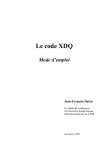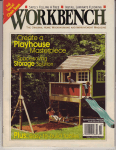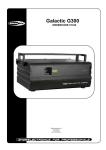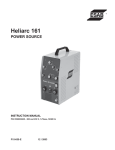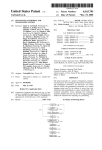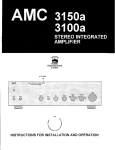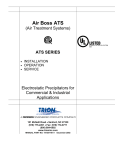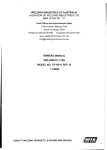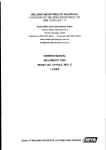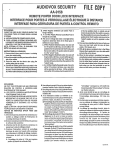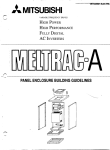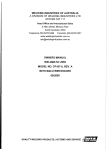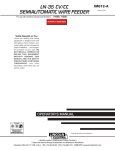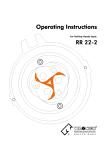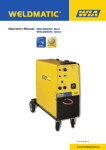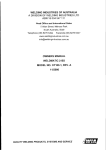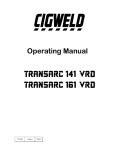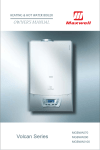Download CP44-3 Weldmatic 335 Internal Feeder Manual
Transcript
WELDING INDUSTRIES OF AUSTRALIA A DIVISION OF WELDING INDUSTRIES LTD ABN 18 004 547 111 Head Office and International Sales 5 Allan Street, Melrose Park South Australia, 5033 Telephone (08) 8276 6494 Facsimile (08) 8276 6327 www.weldingindustries.com.au [email protected] OWNERS MANUAL WELDMATCC 335 INTERNAL WIREFEEDER MODEL NO. CP44-3, REV. C ll/2000 ~ l Q U A L I N WELDING PRODUCTS,SYSTEMS AND SERVICE 4 z V/j.!r J Page 2 WELDMATIC 335 MANUAL Theinformationcontained in this manualissetouttoenableyoutoproperly maintain your new equipment and ensure that you obtain maximum operating efficiency . Please ensure that this information is kept in a safe place for ready reference when future time. required at any When requesting spare parts. please quote the model and serial number of the machine and part number of the item required . All relevant numbers are shown in lists contained in this manual. Failure to supply this information may result in unnecessary . delays in supplying the correct parts SAFETY Before this equipment is put into operation. the Safe Practices section at the back of the manual must be read completely . This will help to avoid possible injury due to . misuse or improper welding applications CONTENTS Sec.1 ................... introduction.................................................... P.3 Sec.2 ................... Receiving....................................................... P.3 Sec.3 ................... Specifications ................................................ P.4 Sec.4 ................... Power Source Controls.................................. P.5 Sec5 ................... installation ..................................................... P.6 Sec.6 ................... Normal Welding Sequence............................ P.9 ............................. P.9 Sec.7 ................... Basic Welding information Sec.8 ................... General Maintenance.................................... P.12 Sec.9 ................... Trouble Shooting........................................... P.12 Sec.10 ................. Service Information........................................ P.14 Sec.11 ................. Parts Lists...................................................... P.16 Sec 12................. Safe Practices ............................................... P.20 1 FIGURES Fig.l.................... Fig.2 .................... Fig.3 .................... Fig.4 .................... Fig5 .................... Fig.6 .................... Fig.7 .................... Fig.8 .................... Fig.9 .................... sembly Source Power Fig.10 .................. .................. Fig.11 Assembly Cable Fig.12 .................. ~ 1 Power Source Controls.................................. P.5 Connection of Supply Cable .......................... P.6 Positive Wire Connection .............................. P.8 Negative Wire Connection............................. P.8 "Good" Weld .................................................. P.11 "Bad" Weld.................................................... P . l l Gun Position.................................................. P . l l Circuit Diagram CP44-3 ................................. P.14 Wirefeed Control BoardCP42-l2 .................. P.15 ................................ ..................................... Gun Wire Drive Assembly..................................... P.18 P.19 WELDMATIC 335 MANUAL Page 3 l.INTRODUCTION Gas Metal Arc Welding (G.M.A.W.) is a basically simple welding process, where a consumable wire is fed by motor driven drive rollers to a welding gun, and where welding current is supplied from the welding power source. The welding arc is struck between the work piece and the endof the wire, which melts into the weld pool. The arc and the weld pool are both shielded by gas flow from the gun, or in the case of "self shielded" wires, by gases generated by the wire core. The process is very versatile in that by selection of the correct wire composition, diameter and shielding gas, it can be used for applications ranging from sheetmetal to heavy plate, and metals ranging from carbon steel to aluminium alloys. The WELDMATIC 335 has been designed to be used with consumable wires in the at range from 0.6mmto 1.6mm diameter. The smaller wire sizes are used when welding lower currents, such as sheet-metal applications. Increasing the wire diameter permits higher welding currentsto be selected. A common application of G.M.A.W. is for welding Mild Steel. In this application, a Mild Steel solid consumable such as AUSTMIG ES6 is used with a shielding gas of Carbon Dioxide, or Argon mixed with Carbon Dioxide. Alternatively, Flux-cored consumables are availablein both gas shielded, and 'gasless' self shielding types. StainlesssteelandAluminiumcanbeweldedwithG.M.A.W.usingthecorrect consumable wire and shielding gas. 2. RECEIVING Checktheequipmentreceivedagainsttheshippinginvoicetomakesurethe in transit, please shipment is complete and undamaged. If any damage has occurred immediately notify your supplier. The CP44-3 package contains; WELDMATIC 335 Power source. (Internal wirefeeder) BEXT2-4E31OAE BERNARD Gun cable, 3 metre, Euro connector. WGAC24 Regulator and Flowgauge. (Argon) (This) Owners Manual. ~ Paae 4 WELDMATIC 335 MANUAL v 3. SPECIFICATIONS Manufacturedto Australian standard AS1 966.1-1 985 PRIMARY 415 Vac, Phase 3 400 Vac. phase 3 380 Vac, Phase 3 0 Hz. 50/60 VOLTAGE Hz. Amps 14 Amps EFFECTIVE 14 PRI. CURRENT 17 OPEN CIRCUIT 18 to 44 Volts VOLTAGE steps. 30 in steps. 30 in steps. in 30 WELDING 35 CURRENT RANGE 14 Amps 20 Amps, 14 kVA MAXIMUM 22 Amps, 16 kVA PRI. CURRENT - 335 AMPS 35 50/60 Hz. 19 Amps, 13 kVA to 43 Volts 16 to 41 Volts - 335 AMPS 35 - 320 AMPS Amps, RATED 190 Amps, OUTPUT 190 @ 25 Volts, 100 % Duty Cycle @ 24 Volts, 100 % Duty Cycle I 9 0 Amps, @ 24 Volts, 100 YO Duty Cycle 260 Amps, @ 30 Volts, 55% Duty cycle 260 Amps, @ 26.5 Volts, 55% Duty cycle 260 Amps, @ 26.5 Volts, 55% Duty cycle 335 Amps, @Volts, 34 32% Duty cycle 335 Amps, @Volts, 31 32 % Duty Cycle 320 Amps, @Volts, 30 35% Duty cycle CIRCUIT BREAKER RATING...... 20 Amps FITTED SUPPLY CABLE .............47/0.20 Four Core, Heavy Duty PVC WIRE SIZE RANGE ..................... 0.6mm - 1.6mm diameter COOLING .................................... Fan cooled, air drawn in through top louvre. INSULATION ............................... Class H, 140°C Rise. DIMENSIONS .............................. L - 870mm, W - 490mm, H - 730mm ~ MASS .......................................... -112kg Duty cycle is defined in Australian Standard AS1966.1as the ratio of arcing time to 5 minutes in any 5 minute period, expressed as a percentage. Paae 5 WELDMATIC 335 MANUAL Y 4. POWER SOURCECONTROLS COARSE VOLTAGE SWITCH FINE VOLTAGE SWITCH POWER ON INOICATOR LIGHT INTERVAL CONTROL SPOT TIME CONTROL ! io WlRE SPEED CONTROL I I ) 7 PRE&POST GAS CONTROLS (INTERNALADJUSTMENTS) FIGURE 1. POWER SOURCE CONTROLS 1. POWER ON INDICATOR This is illuminated when the machine is energised, that is when electrical mains power is connected to the welder, and the Coarse Voltage switch is inpositions 1,2or 3. 2. COARSE VOLTAGE CONTROL This switch provides Coarse adjustment of the Output Welding Voltage over three ranges, plus a'0' power off position. 3.VOLTAGE CONTROL This switch provides ten steps of Fine adjustment of the Output Welding voltage. 4. WIRE SPEED CONTROL The wirefeed speed of the machine is varied with this control; turning the dial in a clockwise direction increases the wirefeed speed, increasing the welding current. 5. SPOT TIME CONTROL When operating the machine in Spot Weld mode, this control will vary the spot weld time. Rotating thedial clockwise will increase the spot weld time,in the range 0.52.5 seconds. If the Spot Weld mode is not required this feature can be turned off by rotating the control anti-clockwiseuntil it 'clicks' intothe minimum position. 6. INTERVAL CONTROL Whenoperatingthemachine in CycleArcmodethiscontrolsets the period betweenwelds.Thespottimecontrolsetstheweldingperiod.Rotatingthe dial clockwise will increase the interval time, in the range 0.5 - 2.5 seconds. If the Cycle Arc mode is not required this feature can be turned off by rotating both controls fully anticlockwise. 7. PRE AND POST GAS CONTROLS Adjustable timers for pre weld and post weld shielding gasare flow available on the CP42-12Wirefeed control board. Refer to Figure 9 for adjustment details. WELDMATIC 335 MANUAL Paae 6 U Adjustable timersfor pre weld andpost weld shielding gas flow are available on the CP42-12 Wirefeedcontrol board. Referto Figure 9 for adjustment details. 5. INSTALLATION CONNECTION TO ELECTRICAL MAINS POWER SUPPLY I NOTE. ~~~ All electrical work shall only be undertaken by a qualifiedelecfrician. I The WELDMATIC 335 is supplied with a 5 metre 4 core 47/0.20 Heavy Duty PVC mains power supply cable. This cable should be correctly connected to a suitable 3 Phase plugtop or fixed connection point. The minimum capacity of the mains wiring and power outlet supplying a welder is selected according tothe effecfive primary currentof the machine. The effective primary 335 is 14 Amps. current for a Weldmatic 335 is 20 Amps. The minimum recommended circuit breaker rating for a Weldmatic Note : The trippingtime of a typical 20A circuit breaker may limitthe duty cycle available from the Weldmatic 335. A higher rated circuit breaker can be selected, but the mains wiring capacity mustbe increased to suit. Thecurrentrating of the mainscabledepends on cablesizeandmethodof installation. Refer to AS/NZS 3008.1, Table 9. If it becomes necessary to replace the mains flexible supply cable, use only cable with correct current rating. Access to the machine supply terminals is gained by removing the power-source side panel opposite to the wire-spool enclosure. Pass the cablethrough the bushfitted to the machinebackpanel.The three phases are terminated at terminal blockas shown in Figure2. Tighten the cableclampleaving just sufficient slack in the cable such that the terminated wires are not in tension. MAINS SUPPLY CONNFrTlQNS l l l I ~ FIGURE 2. CONNECTION OF SUPPLY FLEXIBLE CABLE WELDMATIC 335 MANUAL Page - 7 FITTING THE GUN CABLE TheBERNARDBEQA31OAEguncableisequippedwitha 'Euro'wirefeeder connector which incorporates all required connection pointsto the gun cable for welding current, shielding gas and gun switch control. To attach the gun cable to the wirefeeding mechanism, engage the matingpads of the male and female Euro connectors, then rotate the locking ring clockwise to firmly secure the connection. FITTING THE GAS BOTTLE Depending on configuration of the cylinder to be used, the gas flowmeter / regulator may be fitted directly to the cylinder, or in conjunction with an elbow fitting. DO NOT apply any greaseto these joints, and tighten the nuts securely. Fit the end of thegasinlethosefromthebackpanelof the machine to the connector supplied withthe flow regulator, and secure with the clamp also supplied. FITTING THE CONSUMABLE WIRE The quality of the consumable wire greatly affects how reliably a gas metal arc welder will operate. For best results when welding mild steel, we recommend quality WIA AUSTMIG ES6. Dirty, rusty or kinked wire will not feed smoothly through the gun cable andwillcauseerraticwelding.Depositsfromthewirewillclogtheguncableliner requiring it to be replaced prematurely. Place the spoolof welding wire onto the spool holder. The location pin should mate with a hole provided on the wire spool body. Fit the spool retaining 'R' clip supplied. shoEId be set to prevent over-run of the Check the adjustment of the spool brake, which wire spool at the end of a weld, without unduly loading the wirefeed motor. The braking can be adjusted by the Nyloc nut using a 15/16" AF or 24mm socket wrench. SELECTION OF START MODE The WELDMATIC 335 offers selection between 'Creepv and 'Standard' arc starting modes. In creep mode, the electrode wire is fed at a reduced speed when the gunswitch is first closed. Once the arc is initiated, the wire accelerates full to welding speed. This mode produces a softer arc start which is recommended for aluminium welding applications. If a faster arc start is required, standard mode should be selected. The selector switch is located on the wirefeed control board CP42-12 as shown in Figure 11. Slide the switch upwards to select 'Creep' mode, and downwards to select 'Standard' mode. FEEDING THE CONSUMABLE WIRE/WIRE INCH Withreference to Figure14,releasethepressurescrew ( I O ) , androtatethe pressure arm (8) to the open position. The end of the welding wire can now be passed through the inlet guide, over the bottom driven roller, and into the output wire guide tube Check that the drive roller groove is correct for the wire in use. The appropriate size is stamped onthe visible side of the installed roller. Check also that the correct size contact tip is fitted at the gun end. Drive roller and tip details are available in Section ll of this manual. Return the pressure arm to the closed position and, adjust the compression screw to provide sufficient clamping of the drive rolls drive to achieve constant wirefeed.DQnot over tighten. With the machine energised, close the gun switch to feed wire through the gun cable. If creep speed is selected the wire will be initially fed at reduced speed, however to full welding speed. after a short timed period the rate will increase Paae 8 WELDMATIC 335 MANUAL Y OUTPUT VOLTAGE POLARITY. The design of the WELDMATIC 335 allows selection of the output voltage polarity. POSITIVE WIRE MostG.M.A.W. is carriedoutwiththeworkpieceNegativeandthewelding consumable wire Positive. i o set the machinefor this condition, boit the'WORK lead ontothe (-) output stud, and the 'GUNCABLE' lead to the(+) stud, as in Figure 3. below. NEGATIVE WIRE Some 'seif-shielded' flux cored consumabies are intended to be operated with the to the manufacturers data work piece Positive and the consumable wire Negative. Refer for the particular consumable to be used. To set the machine for this condition, boit the 'WORK' lead onto the (+) output stud, and the 'GUN CABLE onto the (-) stud, as in Figure 4. below. WORK LEAD GUN CABLE LEAD lo ( Q J + FIGURE 3. POSITIVE WIRE GUN CABLE LEAD WORK LEAD 0 0 I FIGURE 4. NEGATIVE WIRE WELDMATIC 335 MANUAL Page 9 6. NORMAL WELDING SEQUENCE WELD START Closing the weldinggun switch initiatesthis sequence of events: The gas valve is energised, gas flow commences and continues for any pre-gas time set; The power source contactoris initiated. Welding voltage is applied betweenthe work piece andthe consumable wire. The wire drive motoris energised. If creep start mode is selected, wirefeed commences at reduced speed. The wire touches the work piece, and the arc is established. If creep start mode is selected, wirefeedrate increases to full welding speed. WELD END Releasing the gun switch initiates this sequence of events: m The wire drive motoris de-energised, andis dynamically braked to a stop; After a short pre-set period, known as the 'burn-back' time, the Power-source contactor functionis released. This period ensures that the consumable wire does not 'freeze' in the weldpool. To adjust the 'burn-back' time, refer Figure to 9. At the completion of any post-gas time set, the gas valve is de-energised and the Figure flow of shielding gas ceases. To adjust the pre and post gas times,torefer 9. 7. BASIC WELDING INFORMATION CHOICE OF SHIELDING GAS The choice of shielding gas is largely determined by the consumable wire to be used. Many proprietary shielding gas mixtures are available. The recommended shielding gases for use with the WELDMATIC 335 are : Mild Steel _.....__..._..__..__._ . _ _ _ Argon _ _ _ _+ . 5 to 25% Carbon Dioxide; Aluminium .._._.._._____.__._........... Argon; Stainless Steel__.____._.............. Argon + 1 to 2% Oxygen. Consult your gas supplier if more specific information is required. Page I O WELDMATIC 335 MANUAL SHIELDING GAS FLOW RATE In G.M.A. welding, one of the functionsof the shielding gasis to protect the molten weld pool from the effects of oxygenin the atmosphere. Without this protection the weld deposit becomes 'honeycombed' in appearance, an effect which is described as weld porosity. In draft-free conditions the gas flow rzte required to give adequate protection is typically 10 litreslmin. In situations where drafts cannot be avoided, it may be necessary to increasethis rate and/or to provide screening of the work area. by airentering the gasstreamthrougha Weld porositycanalsobecaused damaged hose, loose gas connection, or from restriction in the nozzle, such as from excess build-upof spatter. Particularly when welding aluminium, porosity can occur at the start and end of a weld. For this reason it is recommended that some pre and post gas flow time be set. This ensures that the welding zone is protected from atmospheric contamination before the arc is established, and as the weld pool solidifies at the end of a weld. Refer to Figure 11 for adjustment details. ESTABLISHING A WELD SETTING Once the consumable wire type, wire size and shielding gas have been chosen, the hrvo variables that are adjusted in order to obtain a stable arc are; R Wirefeed speed, w Welding arc voltage. Thewirefeedratedetermines the weldingcurrent;increasingthefeedrate increases the current, and decreasing it decreases current. The selected wirefeed rate must be matched with sufficient arc voltage; an increase of wirefeed rate requires an increase of arc voltage. If the voltage is too low the wirewill stub and stutter, and therewill not be a steady arc. If the voltage is too high the arc will be long with the metal transfer within the arc occurring as a series of large droplets. The welding current should be chosen to suit the thickness of the metal to be welded. It is important to check that the deposited weld provides sufficient strength to suit the application. Page 11 WELDMATIC 335 MANUAL A "good" weld will have the characteristics illustrated in Figure 5. The weld has penetrated into the parent metal, fusing the root of the joint where the two plates meet, and the weld blends smoothly into the side walls. A "bad" weld is shown in Figure 6. The weld has not penetrated thejoint root, and by there is poorside wall fusion.Thislackoffusionwouldnormallybecorrected increasing the src voltage, OF by Increasing both wirefeedrateandarcvoltage to achieve a higher current weld setting. B h FIGURE 5. "GOOD WELD FIGURE 6. "BAD" WELD GUN POSITION For "down hand" fillet welding, the gun is normally positionedas shown in Figure 7 below with the nozzle end pointing in the directionof travel. ~ z LA FIGURE 7. GUN POSITION l l e F Page 12 WELDMATIC 335 MANUAL 8. GENERAL MAINTENANCE DUSi Care should be taken to prevent excessive build-up of dust and dirt within the weldingpowersource. It is recommendedthatatregularintervals,accordingtothe prevailing conditions, the machine covers be removed and any accumulated dust be removed by the use of dry, low pressure compressed air, or a vacuum cleaner. WIREFEED In order to obtain themost satisfactory welding resultsfrom the G.M.A.W. process, thewirefeedmustbesmoothandconstant.It is thereforeimportanttoobservethe following points; E Keep the gun cabie liner ciear of dust and swarf buiid-up. When replacement becomes necessary,fit only the correct liner to suit the gun cable model. See Section 11. The build-up of dustin a cable liner can be minimised by regular purging of the liner with dry compressed air. This may be conveniently done each time the wire spool is replaced. Replace the weldingtip as it becomes worn. Keep the wire drive mechanism clean. Periodically check the drive rollers for wear and for free rotation. w Check thatthe consumable wire spool holder rotates smoothly and that the braking actionis not excessive. This also may be conveniently done each time the wire is replenished. 9. TROUBLE SHOOTING UNSATISFACTORY RESULTS WIREFEED Erratic wirefeed is the MOST LIKELY Muse of failure in all Gas Metal Arc Welding. It should thereforebe the first point checked when problems occur. Refer tothe section above. Check for correct gas flow rate at the welding torch nozzle and ensure there are no gas leaks. The gun nozzle must be free from spatterand firmly attachedto the welding gun to ensure that air is not drawn into the shielded area. Check thatthe shielding gas selected is correct for the consumable wire in use. WELDING CIRCUIT Ensure that the work clamp is securely tightened ontothe work-piece so that good electrical contactis achieved. Check also that the output polarity selected is appropriate for the consumable in use. Contamination of the work-piece surface by water,oil, grease, galvanising, paint, or oxide layers can severely disturb the welding arc and result in a poor weld. The contaminating material should be removed before welding. WELDMATIC 335 MANUAL Page l 3 WIREFEED I ARC VOLTAGE RELATIONSHIP If the consumable wire is stubbing into the work piece, and a steady arc cannot be obtained, it is likely that the arc voltage is set toolow to suit the wire speed. To correct this situation either increase arc voltage,or decrease the wire speed. If the arc length is too long, the arc voltage is too high to suit the wire speed. To correct this, increase wire speed or decrease arc voltage. NO WELDING CURRENT Check that Mains Supply is available at the WELDMATIC 335 Power Source, i.e. that the fan is running and the indicator lightis illuminated. Check continuity of the welding current circuit, i.e., work lead, work clamp and gun cable connections. The WELDMATIC 335 weldingpowersourceincorporatesan in builtover temperature thermostat which will trip if the welding load exceeds the operating duty cycle. In this event the machine will not deliver welding current until the machine has cooled sufficiently. The thermostat will reset automatically - do not switch the machine off as the cooling fan will assist the resetting of the thermostat. If the forgoing checks have been made and have not revealed the fault condition, a QUALIFIED SERVICE PERSON should be consulted. i ~ 1 ~ l j l Paae 14 WELDMATIC 335 MANUAL ~~ v ~ ~~~ I O . SERVICE INFORMATION. K 0 r L 0 3 W z n W W Z V .Z E 33. b. wv) W K 3 "K 4: 1 (I S d 0 c. 3 4 W 2 4 I + 2 K u 0 0 f- I+ a G7 U - K 0 0 z Es; W r-+ - ,I x 4 I 4 LL 3 3 G7 v3 L 3 L 3 0 W d -m - * a ri m d -ma l p: % W 0 : cl a w e a x r W E 4 z W-a V a u W O J Q V V I I I ~ r u W V =v/- I @ ) w 3 3 L E o c . r m a & & v 3 L -&L L* m Z Z K K W Wf-W H KOf0 O r l a z a ~ U ab2 w L: ro ur w -r :c u 3 0 a 1) P. 0 W t b I a G7 rl ~ - L " V v I) ,' % L: I -r " P. d b I Ljj - j :k W a I d x ~ a m ~ e m a p x x x x 0 K E 1 V W x x x I cl W b. + \ yy I / \l A AL / $2 Eg u w \ g2 u a= I W V za W I I 0 c b. UE E r n2 G n 35 E l 0 0) L 6 0 V FIGURE 8. CP44-3 CIRCUIT DIAGRAM l 1 T K 0 3 Paae 15 WELDMATIC 335 MANUAL v WIREFEED CONTROL BOARDCP42-l2 The wirefeed control board provides the following functions: Wirefeed motor on/off controlin response to the gun-switch. Speed control of the wirefeed motor. Switchable creepktandard wirefeed start modes. Burn-back control. C Braking of the wirefeed motor at end of weid. Spot-weld timer. Interval timer. Pre and Post gas control timers. Pull gun motor speed calibration, (where pull gun fitted). Local or remote wire speed control. Connections to the board, and service points are detailed in the drawing below. of I 6 0 The circuit is factory calibrated for a maximum push motor drive roller speed rpm. PULLMOTOR +VE PULLMOTOR -VE REMOTE SPEED POT.1K REMOTESPEEDPOT.1K PULLMOTOR FUSE 1.6A STD. ACT. LOCALlREMOTE WRONG INDUCTAN WELDING INDUCTAN START MODE sM7'CH UP=CREEf'START 4- 1 POT 3 CP27-11/26 CP27-11/26 TIMER posTGAs @ x POT 2 (3@MAXPUSl oI -7 H - L PUSH MOTOR MAXSPEED CALLBRATION P ~MINSULL fiwp-\J- PULLGUN CALBRATION BURN BACK T"m-t@ PUSH MOTOR -W PUSH MOTOR +W FIGURE 9. WIREFEED CONTROL BOARD Page l 6 WELDMATIC 335 MANUAL 1l.PARTS LISTS WELDMATIC 335 POWER SOURCE ITEM ii............. PART # ........................ 1 ......................... ..CP42-12 .............................. Includes 1.1 ........................ W11-ii16 ............................ Reiay, 24v (2) 5 ........................... Front Panel Back Panel Centre Panel Base Assembly inciudes 5.1 ........................ CP42-24/6........................... Castor Wheel(2) 6 ........................... 7 ........................... 8 ........................... 9 .......................... 10 ......................... 11 ......................... 12 ......................... 13 ......................... 14 ......................... 15 ........................ 16 ......................... 17 ........................ 18 ........................ 19 ........................ 20 ......................... 21 ......................... 22 ......................... 23 ......................... 24 ......................... 25 ........................ 26 ......................... 27 ......................... 28 ....................... 29 ........................ 30 ......................... 31 ......................... 32 ......................... 37 ......................... Includes 37.1 ...................... 38 ......................... 39 ......................... 40 ......................... 42 ......................... 43 ......................... 47 ......................... 50 ......................... 54 ......................... l Printed Circuit Board CP42-20.............................. CP42-22.............................. CP42-23.............................. CP44-23.............................. 2 ........................... 3 ........................... 4 ........................... ~ .DESCRiFIION CP42-25 .............................. CP42-26.............................. CP42-27.............................. .CP42-28.............................. CP42-29.............................. CP42-30.............................. CP42-31 .............................. CP44-41.............................. CP44-40.............................. .CP42-0/1............................. CP42-32.............................. .CP42-33 .............................. .CP42-34.............................. .CP42-39.............................. W27-2 ................................. TC396-1 .............................. CP101-0/18......................... W1 1-1 /1l ............................ CP27-0/15........................... .CP42-0/2............................. W17-2/12 ............................ CP27-0/18........................... ..CP43-0/8 ............................. .CP43-0/3............................. W1 1-0/16 ............................ W 5 10/19 ............................ LG300 ................................. AM177 ................................ AM133-3 .............................. W11-13 ............................... MC11-32/2 .......................... CP42-0/3............................. CAB4C47HD ....................... HOS5R ............................... SGC030 .............................. CP3-0/23 ............................. MK6/3 ................................. Baffle Panel Side Cover, Fixed Side Cover, Fixed, Lower Side Cover, Opening Top Cover PCB Cover Rectifier Mounting Bracket(2) Welding Transformer Assembly Inductance Assembly Rectifier Assembly Output Terminal Insulating Support Positive Busbar Negative Busbar Handle Assembly Motor and TwoRoll Drive Assembly Euro Gun Adaptor Gas Valve Hose Barb Fan Control Transformer Lens Contactor Coarse Voltage Switch Fine Voltage Switch Potentiometer Knob, Large Potentiometer Knob, Small (2) Work Clamp Spool Holder Assembly R Clip Insulating SpacerBush (2) Nylon InsulatingBush (2) Rubber Tyre Wheel(2) Mains Supply Flexible Cable Gas Hose Steel Chain 650mm Rubber Grommet Terminal Block(2) WELDMATIC 335 MANUAL Page l 7 1 k E Q 1 U O 55 F z 0 K U / @ + C U a Z xW Q6 K E U I 0 I w w u w u w m m > 0 2 ! 2 ! 2 @@ a FIGURE I O . WELDMATIC 335 POWER SOURCE ASSEMBLY Page 18 WELDMATIC 335 MANUAL BEXT2-4E31OAE GUN ASSEMBLY 1 .......BE4392 .......Nozzle 2 ....... BE7497.......Contact Tip 0.6mm ......... BE7488 .......Contact Tip 0.8mm ......... BE7498 ...... .Contact Tip 0.9mm ......... BE7490 .......Contact Tip 1.2mm 3 ....... BE4335 ....... Head 4 .......BE4323R ....Cap 5 .......BE4780 .......Nut Insulator 6 .......BE1 3701 17 .Insulator 7 ....... BE1 3701 16 .Body Tube 8 ....... BE1780006 .HandleKit 9 ....... BE5662 .......Trigger Assembly 10 .....BE1880004 .ScrewKit 14 ..... BE1480012 .Cable Assembly 3M. 15 ..... BE4E213B ..EndFitting 16 ..... BE4305 .......Cone Nut 17 ..... BE2660001 .Terminal 18 ..... BE1520008.Clamp 19 .....BE2520017 .Strain Relief, Flexible 20 ..... BE1 470007 .Bushing 21 .....BE1880135.Strain Relief, Rigid 22 ..... BE2280002. Screw 23 ..... H2072 .........Insulated Link 24 ..... BE4816 .......Nut 25 ..... BE5060 ....... Euro Block 26 ..... BE4421 ........ 0’ Ring 27 .....BE43110 .....Liner 0.9mm-1.2mm To replace liner: Disconnect gun cable assembly from the Euro adaptor on the machine case, remove nozzle (1) and head (3). Withdraw old liner from the wire feeder end. Insert new liner andrefit gun cable assembly toEuro adaptor on the machine case. At the gun end, compressthe liner within thegun cable, then cutit one contacttip length past the end of the body tube (7). Refit head,tip and nozzie. FIGURE 11. BEXT24E31OAE (300 AMP) GUN CABLE ASSEMBLY Page 19 WELDMATIC 335 MANUAL W27-2 MOTOR & TWO ROLL DRIVE ASSEMBLY ITEM #.............PART# ......................... DESCRIPTION 1 .......................... 2 .......................... 3 .......................... 4 .......................... W27-0/1 .............................. W26-0/3 .............................. W27-014 .............................. W27-1/1 .............................. W26-5/8 .............................. W27-0i9 .............................. W27-1/2 .............................. W27-1/4 .............................. Motor l3 Gearbox Screw M6x12 Key Feed Plate Feed Roll 0.9- 1.2mm Positioning Screw Axle Pressure Arm complete W27-115 .............................. W27-1/6 .............................. W27-1/7 .............................. W27-1/8 .............................. W27-1/9 .............................. W27-1/10............................. W26-0/13 ............................. W27-1/11............................. Axle Pressure Arm Spacer (narrow) Pressure Roll Spacer (large) Axle Clip Inlet Guide 2.0mm Pressure Screw complete W27-1/12............................. W27-1/20............................. W27-1/ l 4.. ........................... W27-1/15 ............................. W27-1/ l 6 ............................. W27-1/17 ............................. W27-1/18 ............................. W27-1/3 .............................. W27-1/1 ............................. 9 Thumbscrew Spring Base Pressure Link Pressure Screw Axle Spring Pin External Circlip 4mm ID External Circlip 5mm ID 5 .......................... 6 .......................... 7 .......................... 8 .......................... Includes 8.1 ........................ 8.2 ........................ 8.3 ........................ 8.4 ........................ 8.5 ........................ 8.6 ........................ 9 .......................... 10......................... Includes 10.1...................... 10.2 ...................... 10.3...................... 10.4 ...................... 11......................... 12......................... 13......................... 14......................... 15......................... ALTERNATIVE PARTS (5) ........................ W26-118 .............................. (5)........................ (5) ........................ (5) ........................ (5)........................ (5) ........................ (9) ........................ (9)........................ (9)........................ W 2 6 4 8 .............................. W26-318 .............................. W26-418 .............................. W26-5/8 .............................. W26-6/8 .............................. W27-1/13 ............................. W27-Ul3 ............................. W27-2/13N .......................... Feed Roll 0.8 + l.Omm Feed Roll 1.0 + 1.2rnm Feed Roll 1.O + 1.2mm Alum. Feed Roll 1.2 + l.6mm Feed Roll 0.9 + 1.2mm Feed Roll 1.2 + l.6mm, Knurled. Inlet Guide 3mm Inlet Guide 2.4mm Inlet Guide 2.4mm, Nylon FIGURE 12. W272 TWO ROLL DRIVE ASSEMBLY Paae 20 ~~ WELDMATIC 335 MANUAL Y 12. SAFE PMCTICES WHEN USING WELDING EQUIPMENT These notes are provided in the interests of improving operator safety. They shouldbe considered only as a basic guide to Safe Working Habits. A full list of Standards pertaining to industry is available from the Standards Association of Australia, also various State Electricity Authorities, Departments of Labour and Industry or Mines Department and other Local Health or Safety Inspection Authorities may have additiona! requirements.W I A Technical Note TN7-98 also provides a comprehensive guide to safe practices in welding. EYE PROTECTION NEVERLOOKATANARCWITHOUTPROTECTION.Wear a helmetwithsafetygoggles or glasses with side shields underneath, with appropriate filter lenses protectedby clear cover lens.This is a MUST for welding, cutting, and chipping to protect the eyes from radiant energy andflying metal. Replace the cover lenswhen broken, pitted, or spattered. Recommended shade filter lens. MPG Puked MIG Amps iiG "kW 0-100............ 10 ................. 9 ................... IO ................. 12-13 100-150......... 1 1 ................. 10 ................. 10 ................. 12-13 150-200......... 12 ................. 10-11............ 11-12............ 12-13 200300......... 13 ................. 1 1 ................. 300-400......... 14 ................. 12................. 4QO-503............................ 13 ................. 500 + ................................. ................... " m- 12-13............ 12-13 13 ................. 14 14................. 14 14 ................. 14 BURN PROTECTION. The welding arc is intense and visibly bright. Its radiation can damage eyes, penetrate lightweight clothing, reflect from light-colouredsurfaces, andburntheskinandeyes.Bumsresulting from gasshielded arcs resemble acute sunburn, but can be more severe and painful. Wear protective clothing leather or heat resistant gloves, hat, and safety-toe boots. Button shirt collar and pocket flaps, and wear cuffless trousers to avoid entry of sparks and slag. Avoid oily or greasy clothing. A sparkmay ignite them. Hot metal such as electrode stubs and work pieces should neverbe handled without gloves. Ear plugs should be worn when welding in overhead positions or in a confined space. A hard hat should beworn when others are working overhead. Flammable hair preparations should not be used by persons intending to weld or cut. - TOXIC FUMES. Adequate ventilation with airis essential. Severe discomfort, illnessor death can result from fumes, or cutting may produce.NEVER ventilate with oxygen. vapours, heat, or oxygen depletion that welding Lead, cadmium, zinc, mercury, and beryllium bearing and similar materials when welded or cut may produce harmful concentrationsof toxic fumes. Adequate local exhaust ventilation must beused, or each person in the area as well as the operator must wear an air-supplied respirator. For beryllium, both must be used. Metals coated with or containing materials that emit fumes should not be heated unless coating is removedfromtheworksurface, the area is wellventilated, or theoperatorwearsanair-supplied respirator. Work in a confined space only while it is being ventilated and, if necessary, while wearing airsupplied respirator. WELDMATIC 335 MANUAL Page 21 Vapours from chlorinated solvents can be decomposed by the heat of the arc (or flame) to form PHOSGENE, a highly toxic gas, and lung and eye irritating products. The ultra-violet (radiant) energy of the arc can also decompose trichlorethylene and perchlorethylene vapours to form phosgene. Do not weld or cut where solvent vapours can be drawn into the welding or cutting atmosphere or where the radiant energy can penetrate to atmospheres containing even minute amounts of trichlorethylene or percholorethylene. FIRE AND EXPLOSION PREVENTION. Be aware thatflying sparks or falling slag can pass through cracks, along pipes, through windowsor doors, and through wall or floor openings, out of sight of the operator. Spaks and slag can trave! up to 1Q metres from the arc. Keep equipment clean and operable, free of oil, grease, and (in electrical parts) of metallic particles that cancause short circuits. If combustibles are present in the work area, do NOT weld or cut. Move the work if practicable, to an area free of combustibles. Avoid paint spray rooms, dip tanks, storage areas, ventilators. If the work can not be moved,move combustibles at least 10 metres away out of reach of sparks and heat;or protect against ignition with suitable and snug-fitting fire-resistant covers or shields. Walls touching combustibleson opposite sides should not be welded onor cut. Walls, ceilings, and floor near work should be protected by heat-resistant covers or shields. A person acting as Fire Watcher must be standing by with suitable fire extinguishing equipment during and for some time aRer welding or cuttingif; Combustibles (including bui!ding construction) are within10 metres. Combustibles are further than10 metres but can be ignited by sparks. Openings (concealedor visible) in floors or walls withinI O metres may expose combustibles to sparks. Combustibles adjacentto walls, ceilings, roofs, ormetal partitions can be ignited by radiant or conducted heat. After work is done, check that areais free of sparks, glowing embers, and flames. A tank or drum which has contained combustibles can produce flammable vapours when heated. Suchacontainermust never be weldedonorcut,unless it has first beencleanedasdescribed in AS.1674-1974, the S.A.A. Cutting and Welding Safety Code. This includes a thorough steam or caustic cleaning (or a solvent or water washing, depending on the combustible's solubility), followed by purging andinertingwithnitrogen or carbondioxide,andusingprotectiveequipment as recommended in AS.1674-1974. Water-filling just below workinglevel may substitutefor inerting. Hollow castings or containers must be vented before welding or cutting. They can explode. Never weld or cut wherethe air may contain flammable dust, gas, or liquid vapours. SHOCK PREVENTION. Exposedconductors or otherbare metal in the weldingcircuit, or ungroundedelectrically alive equipment can fatally shock a person whose body becomes a conductor. Ensure that the machine is correctly connected and earthed. If unsure have machine installed by aqualified electrician. On mobile or portable equipment, regularly inspect condition of trailing power leads and connecting plugs. Repair or replace damaged leads. Fully insulated electrode holders should be used. Do not use holders with protruding screws. Fully insulated lock-type connectors should be used to joinwelding cable lengths. Terminalsandotherexposedpartsof electrical unitsshould have insulatedknobsorcovers secured before operation.






















